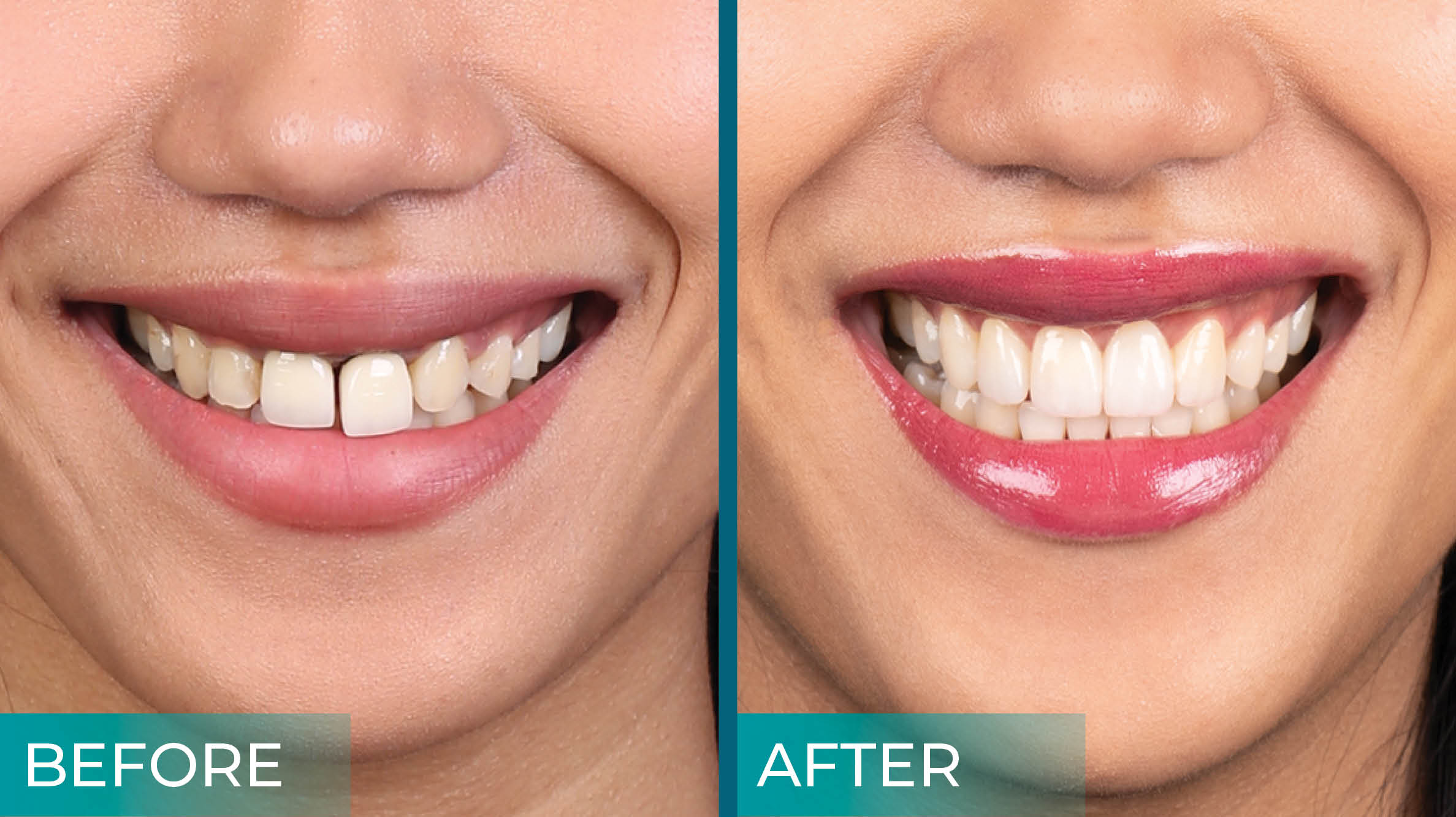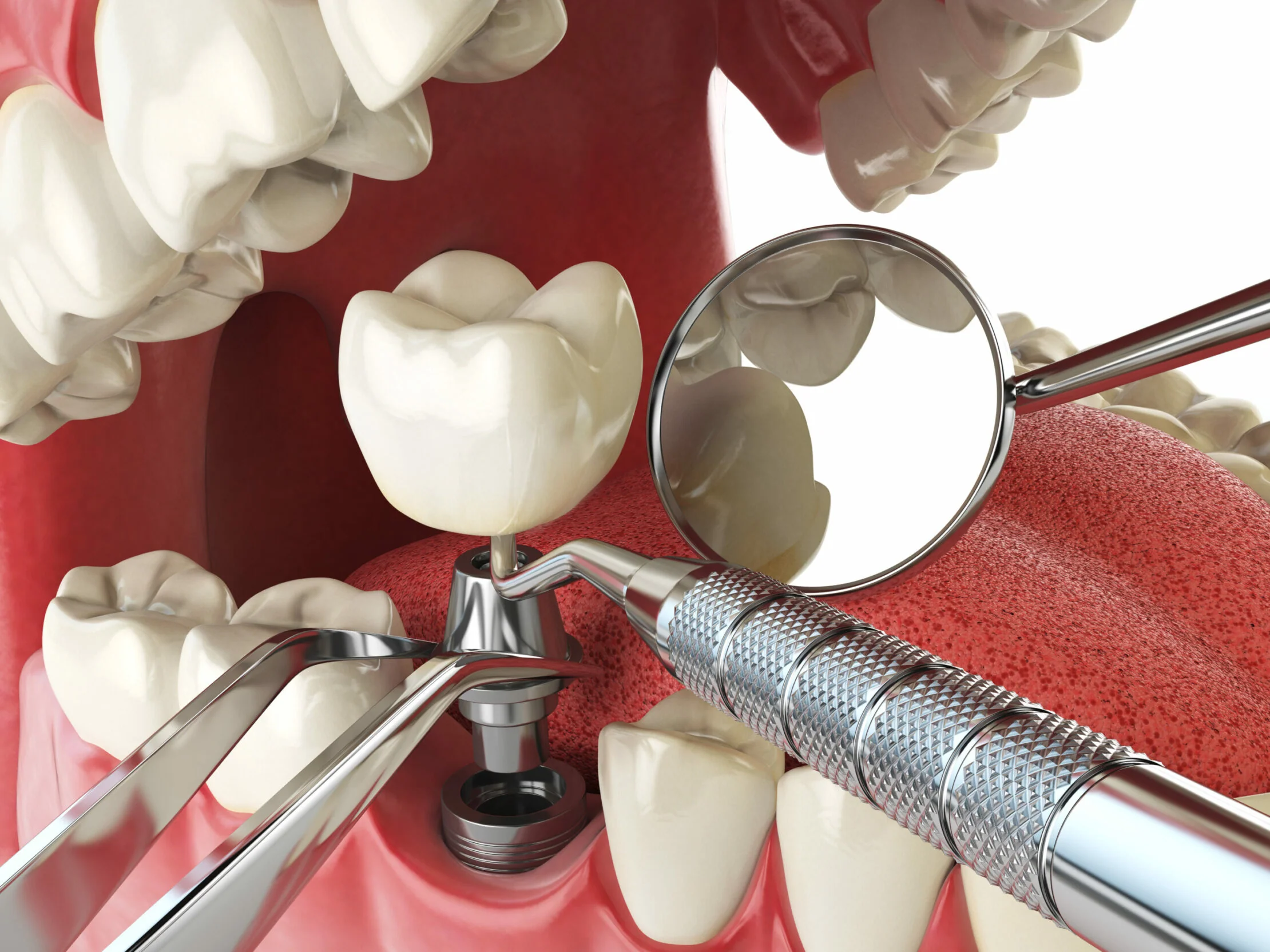
Complete Guide To Dental Implants: Best Way To Replace Missing Teeth
Deciding whether to get dental implant surgery is a big decision. It is an investment not only in your smile but in your self-confidence and comfort. Before making a decision on the procedure or on your dentist, you should be informed. We put together this guide to help you understand every step of the process!
What are Dental Implants?
Dental implants are man-made substitutions for the root structure of the teeth. The root structure is secured into the bone, allowing the tooth or teeth to look and feel more natural. The jaw bone will naturally grow around the implant allowing it to be even more secure within the mouth. With a dental implant, you have the freedom to eat any foods you please because the structure is fixed, unlike a traditional denture.
There are three parts involved in a complete dental implant procedure:
- Implant fixture: The implant is the underlying man-made root structure. This is traditionally made out of titanium for strength and longevity of the implant. There are a wide variety of different dental implants, and not all are created equal. At Serenity International Dental Clinic, we use Nobel BioCare and Swiss SGS dental implants because they have the strongest track records of clinical success over the past several decades.
- Abutment: The abutment is a piece that screws into the implant and provides a surface above the gum line to support the tooth (crown).
- Crown/Prosthesis: The prosthesis or crown refers to the tooth-like structure that the implant supports. The prosthesis can be a single tooth or a full bridge.
There are many advantages to tooth implants. It is a permanent solution to tooth loss that is more durable and stable than alternatives such as conventional dentures, crowns or bridges which can make it easier to speak and eat. They also fit more comfortably and naturally and even look better cosmetically which can improve your self-esteem.
- Permanent and durable
- Natural and comfortable fit
- Look and function more like regular teeth
- Can be more cost effective over many years
- Require less maintenance
- Don’t require modifications to adjacent teeth
- Prevent further bone loss and shifting of existing teeth
- 95%+ success rates
Convenience is another huge advantage as they do not need to be removed, cleaned or kept in place by messy adhesives. They also improve oral health by making it easier to clean between teeth and they do not require modifications to nearby healthy teeth in order to be installed.A missing tooth or teeth can take away from the smile that’s really you, but tooth loss can have many negative effects on your oral health, including:
- Bone loss
- Shifting and drifting teeth
- Bite changes and chewing difficulty
- Wearing down of remaining teeth
- Changes in the jaw joint
Why the jaw bone needs teeth to maintain shape?
In a healthy mouth, the tooth root transmits chewing forces to the jaw, and this helps to maintain the bone – and keep natural teeth stable. If one or more teeth are lost, these forces cease and the bone may slowly recede. As a result, neighboring teeth may also move inwards, creating additional gaps, as shown in the illustrations below
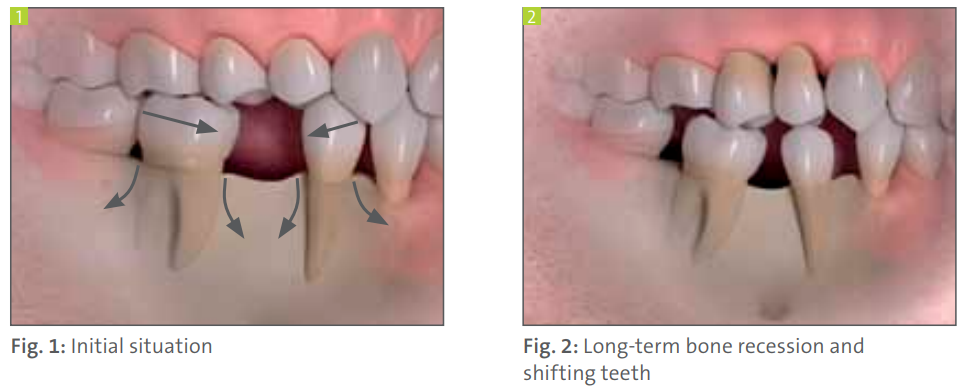
If you suffer from multiple tooth loss, bone atrophy and facial change can continue, under conventional restorations, such as bridges or partial prostheses. Dental implants can help to prevent the bone deterioration described above, since the implant mimics a natural root, transmitting chewing forces to the jaw bone and preventing bone loss.
 Am I a Candidate for Dental Implants?
Am I a Candidate for Dental Implants?
Your dentist will be able to determine if you are a candidate for implants after completing the following checks:
- Examination of your mouth and teeth
- Evaluation of your medical & dental histories
- X-rays of your mouth
- CT scan
These evaluations will tell the dentist how much bone you have in your jaw as well as the location and shape of your sinuses and nerves.
Good Candidates
To be a candidate for implants, one must have healthy gums and a strong jawbone with enough bone to fuse with and support the implant. However, some bone can be rebuilt via a bone graft if the patient has already last some bone in their jaw. It is also very important that the patient make a commitment to great oral hygiene (brushing, flossing, visiting the dentist).
Poor Candidates
There are a number of contraindications that may complicate or completely disqualify you from implant treatment, including chronic diseases, smoking heavily and alcohol abuse which all reduce the rate of healing and can significantly increase the chance of failure.
Patients who many not be good candidates for implants include:
- Pregnant women
- Heavy smokers
- Alcohol or substance abusers
- Young people whose jawbones are still growing
- Uncontrolled diabetes
- Immune deficiencies
- Hemophilia
- Teeth grinding or clenching
- Medicines that suppress the immune system such as steroids
- Connective-tissue diseases
- High-dose radiation treatment of the head or neck
NOTE:
Even if you have one or more of the conditions above, you may still be a candidate for implants. It highly depends on the recency and severity of the condition.Pain is a common concern among individuals who are considering dental implants. As with any major dental procedure (or surgery in general), some discomfort is to be expected during the recovery process since it is a surgery that typically involves removing teeth, cutting gums, drilling into the jawbone and inserting a titanium post.
Will There be Pain During the Surgery?
The procedure should be completely trouble-free, but there can be some discomfort. Your surgeon will perform the operation with local or general anesthesia so that your gums and jaw are completely numb.
You might hear/feel the tools being used, but no agony should be experienced. Those who have a phobia of dental/surgical procedures can opt for sedation, which allows them to be relaxed the entire time, while still being conscious.
Will There be Pain After Surgery?
The complexity of the operation can impact the amount and duration of soreness afterwards. Having a bone graft or sinus lift done before your surgery will typically cause additional tenderness afterwards.
You may also experience side effects such as bruising, swelling and bleeding to a certain degree depending on your gum and bone health. The experience varies from person to person and depends on how quickly they heal.
Almost all of the swelling should be gone in the first 3-5 days after the surgery and the pain should be almost completely gone after 7-10 days.
If you notice any signs of swelling, infection or irritation after the timelines mentioned above, you should seek medical attention. They can check the implants and surrounding gum tissue and repair and minor problems. If these signs last for more than two or three weeks then something might be wrong with it.
With plenty of rest, painkillers, and ice packs, you should be able to minimize the amount of pain you experience after your surgery. A few days of pain and discomfort is a small price to pay for long-term dental health and a great looking smile.
There are multiple stages to dental implant surgery:
- Consultation
- Implant placement
- Abutment placement
- and the permanent tooth.
If you are replacing a damaged tooth, then the first step is tooth extraction. If you are placing a tooth where one is missing but have undergone some degree of bone loss, then the first step will be preparing the jaw for surgery, which includes any necessary bone grafting and/or sinus lifting.
From the first consultation appointment to cementing the final crown, the procedure typically takes a minimum of 6 months.
The implant procedure timeline also depends on: the rate at which the patient heals, condition of the jawbone, type of implant used, location and number of teeth being restored as well as technique used to place the implant(s).
Your dentist or implant specialist should be able to provide you with a detailed treatment plan including an estimated timeline of each appointment and surgery in the process after an initial consultation and examination.
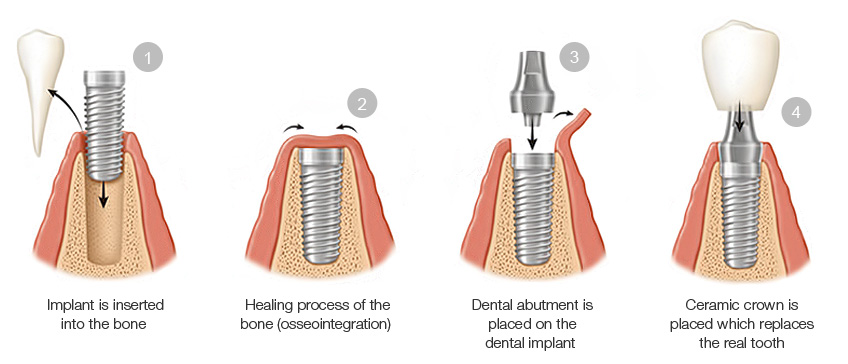
If the X-rays show that your jawbone isn’t thick enough to support an implant or you don’t have sufficient bone density, a bone graft may be required to build up the bone. This is often the case when a tooth has been missing for a long time because bone density decreases over time when there is no tooth root stimulating the jawbone.
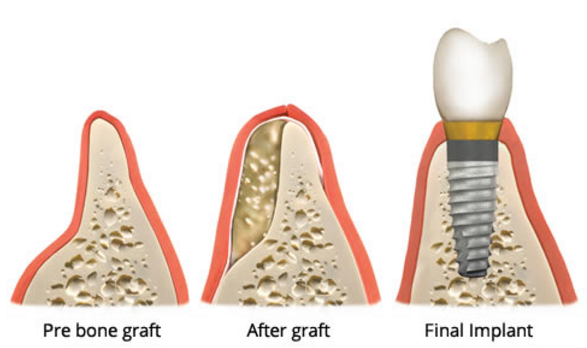
The bone used in grafting can be taken from your chin, hip or hip, processed cow or pig bone or synthetic material such as calcium phosphate or hydroxyapatite.
An alternative to grafting, bone distraction which is a procedure that involves pulling apart the existing bone at the site with screws and pins and letting it heal to fill in the gaps.
Bone grafts can sometimes be done during the surgery to place the dental implant, but large grafts (more than 1 implant or a lot of bone tissue involved) must be done in a separate procedure beforehand.
If a graft is necessary, it will add one or more surgeries and from 3 to 12 months of healing to the timeline.1 surgery followed by 3 to 6 months of healing.
Once your dentist has confirmed that there is enough bone in your jaw to support the implant(s) successfully, the first surgery can be scheduled.
The first surgery is to place the implant(s) into your jawbone in the space created by the missing tooth and takes around 1 to 2 hours. It is performed by an oral surgeon, periodontist or dentist who has additional training in implantology.
Most dental implants are placed with the use of a local anesthetic. If you are nervous about the procedure or getting multiple implants, then you should ask to be sedated by intravenous sedation. Your surgeon should discuss all of these options with you.

First, a small incision is made in the gums to expose the bone.
Your dentist will then drill into your jawbone, gradually widening the hole until it is the correct size for the dental implant. This stage is critical as the jawbone must be treated very carefully to avoid damaging the surrounding bone (bone burn) or nearby nerves and sinus cavities.
The implant is then screwed down into place until it is flush with the bone.
Next, the gum tissue is folded over the implant and stitched back into position. This ensures the area is protected from any external forces, allowing it to heal and integrate with the implant – a process known as osseointegration.
Healing and Bone Growth (Osseointegration)
New bone cells grow on and around the implant, fusing it into your jawbone. The time it takes to fully integrate with the surrounding bone varies from person to person, but typically takes 3 to 6 months.
Once this process is complete, the second stage of surgery can begin.Your dentist will take an x-ray to confirm that the implant has fused with the surrounding jawbone. If it has, then they will schedule the second surgery.
The second surgery is much quicker, simpler and less-invasive than the first.
First, your dentist will make an excision in the gum tissue to expose the top of the implant(s).
After confirming that the implant has fully integrated with your jawbone, a healing cap (or “collar”) is screwed into it. The collar is a smooth, rounded piece of metal that guides the gum tissue into healing in the correct size and shape.
The collar is left in place and the gums are given 5 to 12 days to heal around it. This way your gums will fit around the crown in the same way as your natural teeth.
If you had a removable partial denture before getting implants, your dentist will modify it so it will fit over the healing cap during this time.
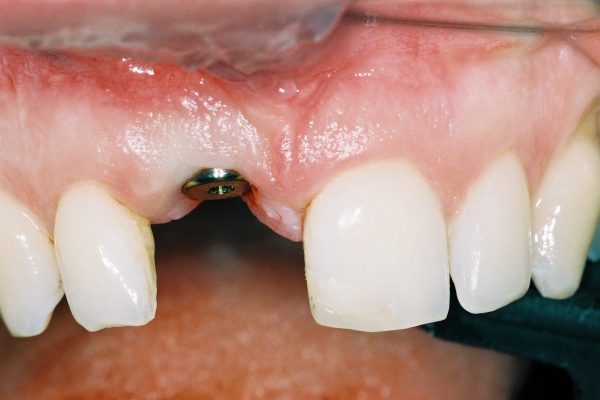
Once the gums have healed tightly to the collar, the collar is removed.
The abutment is then screwed into the implant using special equipment to ensure it won’t come loose. It provides the surface area needed to attach and support the temporary crown.
An impression is then taken of your abutment(s) as well as the surrounding teeth and gums and used to fabricate the final restorations.The permanent crown is fabricated over the course of 3 – 5 days
Once it is ready, the new custom-made tooth (restoration) is cemented or screwed onto the abutment. This completes your smile and restores your ability to talk and eat normally.
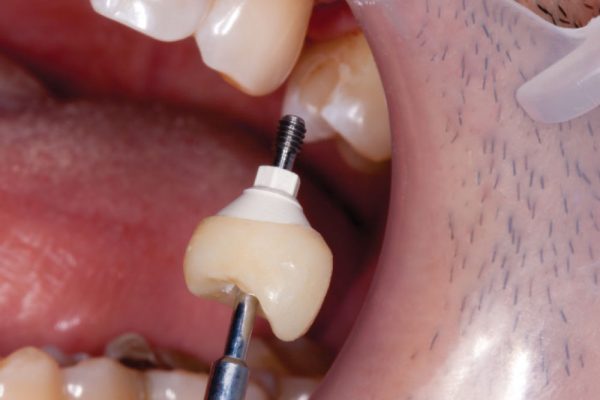 The procedure is more likely to be problem-free if you:
The procedure is more likely to be problem-free if you:
1) Have Excellent Oral Hygiene
It is vital to ensure you clean around your implant thoroughly so it is kept free from plaque and food debris. They will show you the best way to clean an implant and give you special interdental brushes or soft/water picks to help you clean the area more effectively.
Failure to brush and floss properly is the main reason for implant failure as it can cause the bone and gum tissue surrounding the implant to become infected.
2) Get Regular Check-ups
Visit the dentist every six months for check-ups and cleanings, or more frequently if recommended. This will help keep your mouth healthy and catch any problems that arise.
3) Avoid Bad Habits
That could damage your dental implants. Don’t chew on ice, hard candy or other hard substances as this could damage your implant crowns, or even your natural teeth.Dental implant surgery is generally very successful with rates typically between 95% and 97% (see this study and this one for statistics), but everyone is different and your dentist can discuss your suitability as well as their personal success rate.All surgeries involve some amount of risk, and placing dental implants is no exception. That said, problems with dental implant surgery are rare and tend to be minor and easily treatable. Risks include:
Infection
While rare, if there is bacteria present during surgery, an infection may develop near or under the implant which can cause it to fail.
Excessive Force
An implant may also fail if it is subjected to an excessive amount of force from grinding, clenching or biting hard objects. This can also happen if the teeth (artificial and natural) don’t fit together properly when the patient bites down.
These pressures may cause bone loss around the implant which can cause it to become loose and eventually fail.
Nerve Damage
There is a major nerve that runs through your lower jawbone. This nerve can be damaged by the drill or implant placement during surgery, which can cause numbness, pain or a tingling sensation in the jaw, lip, tongue or chin area. In some cases the nerve is able to heal completely and the numbness is temporary, but it can also be permanent.
This problem is very rare as long as your dentist takes a computed tomography (CT) scan and X-rays beforehand to locate and avoid the nerve.
Sinus Problems
If an implant being placed in the upper jaw is placed too near or protrudes into the sinus cavity (located above your upper teeth) it will cause significant discomfort and potentially an infection.
To prevent this from happening, your dentist will use the X-rays taken during the initial examination to locate and avoid your sinuses and nerves.
Damage to Nearby Blood Vessels and Teeth
Placing an implant is a delicate and challenging procedure, but a skilled and experienced surgeon will not damage any nearby structures including teeth and blood vessels.


